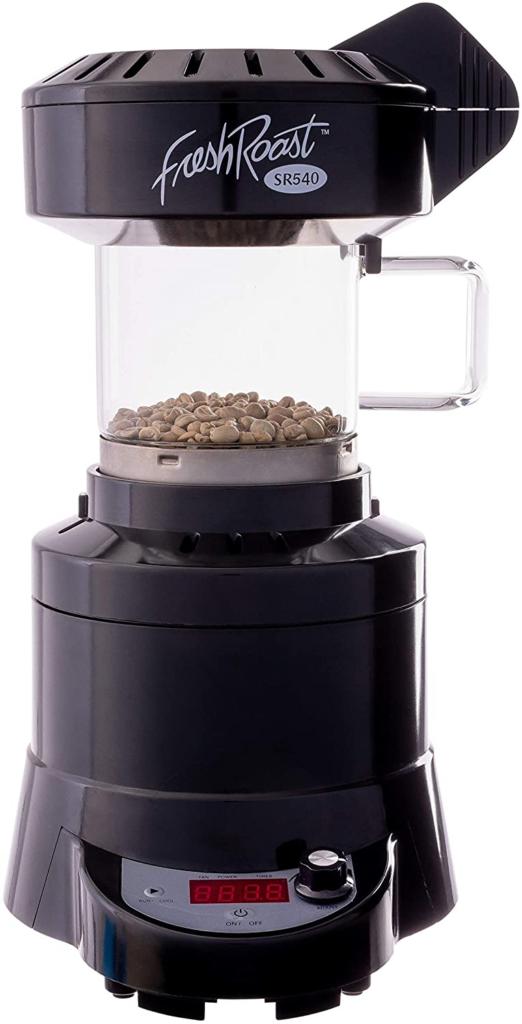It’s been said that:
Roasting beans at home is an exciting experience.
I mean, think about it…
Having complete control over the flavor of your beans and learning to tweak it to work perfectly with your taste buds.
Awesome, right?
Well, the feeling of perfecting a roast is, simply, indescribable to a coffee lover.
But, is it easy to do?
In many ways, yes. Generally, the process of roasting coffee beans is not too difficult or complex.
Once you have a basic understanding of coffee bean roasting, the process should take 10-15 minutes.
It is perfecting this process that takes time and effort.
Table of Contents
What You Will Need
Before you consider roasting from home, there are a few thing items you will need. For example:
- Green, unroasted coffee beans of your choosing
- A Coffee Bean Popper machine (or Popcorn popper)
- A wooden spoon for stirring
- Large bowl and colander (preferably metal)
- Some oven mitts
- And enough time to roast the coffee
But first:
Here’s a quick overview of the most common types of coffee roasts.
Today’s Most Popular Grades of Coffee Roasts
Now:
While you may be able to roast the beans without a thorough understanding of every technical aspect, I recommend learning a few basics.
For example, what are the different levels/grades of roasted coffee beans?
a) Raw/Green Coffee Beans (Unroasted)
Notably:
Coffee often starts out as raw, green beans.
Before the roast begins, you can do a “drying stage” to rid the beans of all remaining moisture. The ideal drying temperature for raw beans is about 113ºF.
At this point, the beans will be rich in their berry flavor. It’s important to note that dry beans are essential for a successful roasting process.
b) Light Roast Coffee Beans
Once your unroasted beans have dried out fully, you can start roasting them.
Now:
The first thing you’ll note is that the coffee beans will start turning brown and darkening over time.
After roasting for about 5-6 minutes, they should turn to a light brown color.
Moreover:
The aroma of the bean will fill the room while releasing the flavor of the bean. At this point, some roasters often work on creating a profile of the beans.
And:
To mark the end of this roasting stage, your beans will develop their “first crack” from the pressure; i.e. you will hear them pop – similar to popping corn.
c) Medium Roast Coffee Beans
After further roasting:
More moisture will be released once the beans have cracked and, thereafter, all the water in them will evaporate.
This stage is characterized by a slight darkening of the beans’ color from light to dark brown.
d) Dark Roast Coffee Beans
Now:
After a few more minutes, a “second crack” will appear on each bean and they’ll turn darker (almost, entirely black in color).
This is usually the final stage of roasting coffee beans.
Obviously, you should expect a lot of changes in the physical appearance, taste, and effectiveness of your coffee beans after roasting.
Anyway:
With that in mind, here’s a quick rundown on how to properly roast your coffee beans at home…
Coffee Beans Roasting Process – Step by Step Guide

Now:
This is where you get to put your knowledge and roasting skills to the test.
My assumption is that you have access to a home roaster. But if you don’t, a popcorn popper machine will work too.
But:
It should be noted that popcorn machines could get damaged during the process. Thus, using a home roaster is more convenient and guarantees a consistently roasted coffee bean.
So, here’s how you should go about it:
Step 1: Move the Roasting Machine to a Ventilated Space
Roasting coffee beans can produce a lot of smoke.
Get this:
While it may smell great to some people, it can be choky to others. So, to be safe, move the machine to a place where there is a decent amount of ventilation.
Step 2: Add Your Dry, Raw Coffee Beans
Now:
Depending on your machine’s size or capacity, add a decent amount of coffee beans.
And, if you are using a popcorn popper machine, ensure that your beans fill up less than half of the heating container’s volume to give room for expansion.
Step 3: Turn the Machine On to Start the Process
At this point:
You can turn the machine on.
After some time, you’ll start to see smoke.
Note:
Heating requires your full attention. Why?
Because despite starting off as endothermic, coffee bean roasting turns exothermic at around 347ºF. This simply means that the temperature will rise rapidly if not readjusted to accommodate this change.
Step 4: Monitor the Process and Listen for the “First and Second Crack”
So:
This step depends greatly on the type of roast or coffee bean grade you want.
Once you hear the first cracks, your beans will be lightly roasted. If your goal was to get light roast coffee beans, turn the machine off and allow the beans to cool off.
For a medium roast, give the machine a few more minutes after the first crack; until the beans become dark brown.
For a dark roast, wait until you hear the second load of cracks. Turn the machine off soon after the second crack to avoid excessive roasting or turning the beans to charcoal.
Step 5: Cool the Roasted Beans
If you’re lucky:
Your coffee roaster has a cooling system built-in; so, you may not need to do this step.
However, if your machine does not have this feature, turn it off and place the roasted beans in a metal bowl or colander (or even a tray).
Safety tip:
Wear oven mitts to avoid burning yourself.
You can attempt to cool the roasted beans down by tossing them in the air, carefully. This will also help to remove the chaff.
Anyway:
After cooling the roasted beans, you can pick out the remaining chaff. Some coffee lovers believe that chaff adds to the flavor slightly, do you?
I’ll let you be the judge of that.
Step 6: Allow the Beans to Degas
Coffee beans usually contain CO2 gasses.
These gasses are not only unhealthy but also tend to alter the taste of the coffee. That’s why it’s wise to avoid them.
So:
After the roast process is complete, these gases get slowly released from the bean.
That’s why experts recommend you leave the beans to degas for about 12 to 24 hours before grinding and brewing fresh coffee.
Conclusion
And that’s it.
Yes – home coffee roasting can be a truly exciting experience.
In fact, you will never forget that first cup of fresh coffee you successfully roasted. And, evidently, the whole process is only a few steps long and not too difficult to learn.
The trick to roasting coffee beans at home like a pro is to practice.
Though it only takes a few moments to learn how to roast coffee beans, mastering the process takes time and practice.
So, what’s stopping you? It’s time to give home coffee roasting a try.
Do you have any questions or thoughts/tips you’d like to add to this? Join the discussion by commenting below.
I’d love to hear from you.
Frequently Asked Questions about Roasting Coffee Beans
Well, this depends entirely on three things:
The type of roasting machine; how fast does it heat up? How well does it distribute/dissipate heat?
How much coffee is being roasted; a small or large batch?
And the type of roast you want to achieve; light, medium, or dark
Roasting your own coffee beans can be fun and cost-effective. However, it also takes time, skill, and effort to execute a successful roast.
Needless to say:
If you’re not careful, you also run the risk of burning the beans or not getting the process done right.
Yes, you can roast coffee beans from home.
And, even better, it can be done using common household items such as a pan, oven roasting, or a popcorn machine. And, with sufficient knowledge, you can give microwave roasting a try.
But, for those who don’t like taking shortcuts, purchasing a home coffee roaster is the best way to go about this.
A medium roast is the safest option if you are unsure about what you want.
This is widely debated in the coffee community. However, each bean has characteristics that determine which roast is necessary to release (optimize) its flavors.


